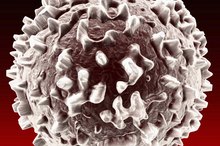What Are the Causes of Low White Blood Cell Count & Weight Loss?
White blood cells, also called leukocytes, function to protect the body from foreign invaders such as bacteria and viruses. Five major types of white blood cells exist, each performing important functions in the immune system. An adult’s normal white blood cell count ranges from 4,500 to 10,000 white blood cells per microliter, according to MedLine Plus, a publication of the National Institutes of Health 1. Many diseases and illnesses decrease the number of white blood cells, making the body vulnerable to infections. These same diseases also commonly cause weight loss.
If you are experiencing serious medical symptoms, seek emergency treatment immediately.
Lupus
Lupus, a chronic inflammatory disease, occurs when the body’s immune system attacks health tissues in the body, classifying it as an autoimmune disease. Lupus affects many systems of the body including the joints, skin, kidneys, heart, lungs, blood vessels and brain. The symptoms depend upon the system affected, but often include weight loss. Lupus can attack and destroy the white blood cells leaving the body vulnerable to infections. The treatments for lupus, including corticosteroids and cytotoxic drugs, also destroy white blood cells, increasing the risk of infections further.
- Lupus, a chronic inflammatory disease, occurs when the body’s immune system attacks health tissues in the body, classifying it as an autoimmune disease.
- Lupus can attack and destroy the white blood cells leaving the body vulnerable to infections.
Hairy Cell Leukemia
Drugs That Cause Peripheral Neuropathy
Learn More
Hairy cell leukemia describes a specific type of leukemia that occurs when the bone marrow produces too many lymphocytes--a type of white blood cell 3. The lymphocytes produced; however, are abnormal and appear “hairy” under a microscope. These abnormal lymphocytes build up in the bone marrow and blood, leaving no room for healthy white blood cells, as described by the Cleveland Clinic 3. Signs of hairy cell leukemia include weakness, fatigue, frequent infections and weight loss for no apparent reason 3.
HIV and AIDS
Human immunodeficiency virus, HIV, causes a life-threatening illness known as acquired immunodeficiency syndrome, or AIDS. AVERT.org, an international AIDS charity, reported in December 2009 that AIDS had caused the deaths of 25 million people since 1981. HIV uses CD4 cells, a specific type of white blood cell known as T helper lymphocytes, to replicate itself, producing more virus particles. This damages and destroys CD4 cells, lowering the white blood cell count and leaving the immune system vulnerable to infections. The illness AIDS occurs when the level of CD4 cells falls too low, meaning the body cannot effectively fight infections. Symptoms include fever, diarrhea, swollen lymph nodes and weight loss.
- Human immunodeficiency virus, HIV, causes a life-threatening illness known as acquired immunodeficiency syndrome, or AIDS.
- HIV uses CD4 cells, a specific type of white blood cell known as T helper lymphocytes, to replicate itself, producing more virus particles.
Leishmaniasis
Autoimmune Diseases That Cause Abdominal Pain
Learn More
Leishmaniasis describes a parasitic diseases caused by an infection with Leishmania parasites transmitted by the sand fly. This disease most commonly affects those in the tropics, subtropics and Southern Europe, as described by the Centers for Disease Control and Prevention 5. Leishmaniasis may remain cutaneous causing painful skin sores, or become visceral affecting the internal organs. Visceral leishmaniasis causes fever, weight loss, an enlarged spleen and enlarged liver. Patients with visceral leishmaniasis also produce abnormal blood tests, showing a low red blood cell count and a low white blood cell count.
- Leishmaniasis describes a parasitic diseases caused by an infection with Leishmania parasites transmitted by the sand fly.
- Leishmaniasis may remain cutaneous causing painful skin sores, or become visceral affecting the internal organs.
Related Articles
References
- Medline Plus: WBC Count
- MayoClinic.com: Lupus
- The Cleveland Clinic: Hairy Cell Leukemia
- AVERT: Worldwide HIV and AIDS Statistics
- Centers for Disease Control and Prevention: Leishmania Infection
- Leukemia and Lymphoma Society. Hairy cell leukemia facts. Updated October 2013.
- Hairy Cell Leukemia Foundation. Understanding hairy cell leukemia: Diagnosis, treatment and beyond.
- Bohn JP, Gastl G, Steurer M. Long-term treatment of hairy cell leukemia with interferon-α: still a viable therapeutic option. Memo. 2016;9:63-65. doi:10.1007/s12254-016-0269-1
- Grever MR, Abdel-Wahab O, Andritsos LA, et al. Consensus guidelines for the diagnosis and management of patients with classic hairy cell leukemia. Blood.2017;129(5):553–560. doi:10.1182/blood-2016-01-689422
- NIH National Cancer Institute. Hairy cell leukemia treatment — Patient version. Updated October 30, 2019.
Resources
Writer Bio
Stephanie Chandler is a freelance writer whose master's degree in biomedical science and over 15 years experience in the scientific and pharmaceutical professions provide her with the knowledge to contribute to health topics. Chandler has been writing for corporations and small businesses since 1991. In addition to writing scientific papers and procedures, her articles are published on Overstock.com and other websites.









